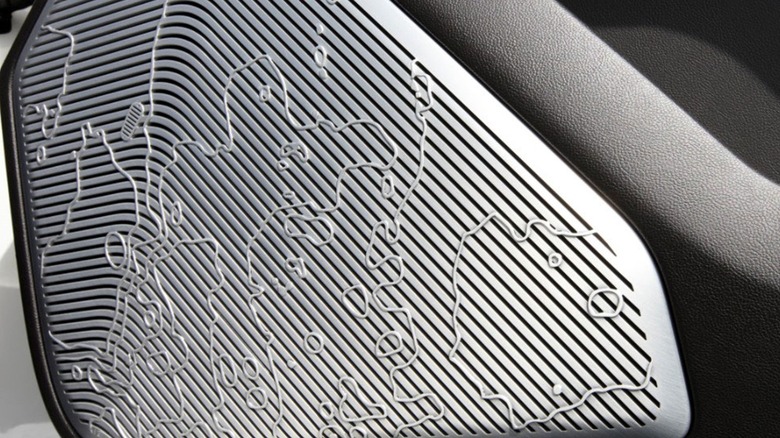The Hidden Map On The Hummer EV And What It Means
The Hummer, once a monster of the gas era, has been reimagined by GM as an all-electric beast, and it sold fast. As reported by CNBC in March 2022, GM received 65,000 reservations for the Hummer EV in its pickup and SUV versions, ultimately having to level up production to meet demand. With its classic off-road character, loved by urban and rural drivers alike, the all-American classic can do 0-60 mph in about 3.5 seconds in its SUV version, while the pickup version cuts that time to just 3 seconds, according to GM.
The new Hummer has 830 to 1000 horsepower, depending on the model, and up to 11,500 lb-ft of torque. The model reclaimed its place in the market with 300 to 350 miles of range when fully charged, a unique "crab walk" mode, its rough exterior, and next-level technology. But few in the Hummer fanbase may know about an easter egg GM hid inside the car: a moon map.
Why does the new Hummer have a map of the moon?
GM carved a topographic map of the moon's Sea of Tranquility in the interior of its new Hummers. The map of the Sea of Tranquility honors the exact location where Apollo 11 Commander Neil Armstrong and Edwin "Buzz" Aldrin landed in 1969. The Hummer comes with two interior design options called "Lunar Shadow Interior" and "Lunar Horizon Interior," and GM explains that they were inspired by "intergalactic travel and otherworldly landscapes." The Sea of Tranquility map is found on the Hummer's speaker grilles, though only with the Edition 1 trim level. The unique design does raise a big question: why does GM have a lunar fixation?
Hummer Nation reports that GM linked its electric transformation to a defining moment in American history. There is also no denying that the Hummer is known for its extreme off-track capabilities, which could be compared to driving on other planets, but the truth is that there is much more behind it. On July 30, 1971, the Apollo 15 mission landed on the moon and deployed the first vehicle ever driven beyond our planet. The 1971 lunar rover was built by GM and Lockheed Martin. It extended the capabilities of astronaut exploration to become a world-famous icon of the Apollo days. In 2021, both companies teamed up once again to build a new lunar rover, one worthy of the return of humanity to the moon under NASA's Artemis program.
Meet the new GM and Lockheed Martin lunar rover
Lockheed Martin says that rovers on the moon are necessary if lunar exploration is to be taken seriously. Only 5% of the lunar surface has been explored, and rovers could help bring those numbers up. NASA's Artemis Base Camp plan calls for different types of rovers to be designed; some will be autonomous and used for resource exploration and extraction. Other rovers will transport astronauts. NASA wants one of the rovers to be built as a mobile home, and another, the Lunar Terrain Vehicle (LTV), for rapid crew transportation.
The LTV will be an unpressurized open-top rover that astronauts will drive while wearing their full gear. On the other hand, the mobile home rover will allow for longer journeys and exploration missions, and astronauts won't need to wear their suits while inside. Additionally, NASA wants it to have all the security, capabilities, and comforts that a mobile home on the moon should have.
GM is building on its defense and off-road experience, as well as on its lunar experience from the Apollo missions. The new rovers will have to drive through nights that can last up to 14 days, rugged terrain, dangerous craters and boulders, dust and lunar sands, and endure extreme temperatures and radiation. "GM is a world leader in automobile manufacturing and technology, and Lockheed Martin is a world leader in spacecraft. The two companies joining forces to build a mobility system on the moon just makes perfect sense," Kirk Shireman, vice president, of Lunar Exploration Campaigns at Lockheed Martin said.


